2025

Sparse Sequential Bayesian Learning of Long-term Thermomechanical Performance of Energy Piles from Limited Multi-parameter Monitoring Data
Bo Sun, Chao Shi# (# corresponding author)
Canadian Geotechnical Journal 2025
Energy piles combine structural support with ground-source heat exchange, enabling effective seasonal thermal storage. However, long-term cyclic thermal loads on piles can induce complex thermo-mechanical interactions with surrounding soils. Predicting the long-term performance of energy piles is crucial for reliable foundation design but remains challenging due to limited monitoring data, significant parameter uncertainty, and the high computational cost of fully coupled numerical analyses. To address these challenges, this study proposes a multi-objective sparse ensemble learning (MO-SEL) framework that combines physics-informed load transfer functions with sequential sparse Bayesian learning to predict long-term pile performance.
Sparse Sequential Bayesian Learning of Long-term Thermomechanical Performance of Energy Piles from Limited Multi-parameter Monitoring Data
Bo Sun, Chao Shi# (# corresponding author)
Canadian Geotechnical Journal 2025
Energy piles combine structural support with ground-source heat exchange, enabling effective seasonal thermal storage. However, long-term cyclic thermal loads on piles can induce complex thermo-mechanical interactions with surrounding soils. Predicting the long-term performance of energy piles is crucial for reliable foundation design but remains challenging due to limited monitoring data, significant parameter uncertainty, and the high computational cost of fully coupled numerical analyses. To address these challenges, this study proposes a multi-objective sparse ensemble learning (MO-SEL) framework that combines physics-informed load transfer functions with sequential sparse Bayesian learning to predict long-term pile performance.
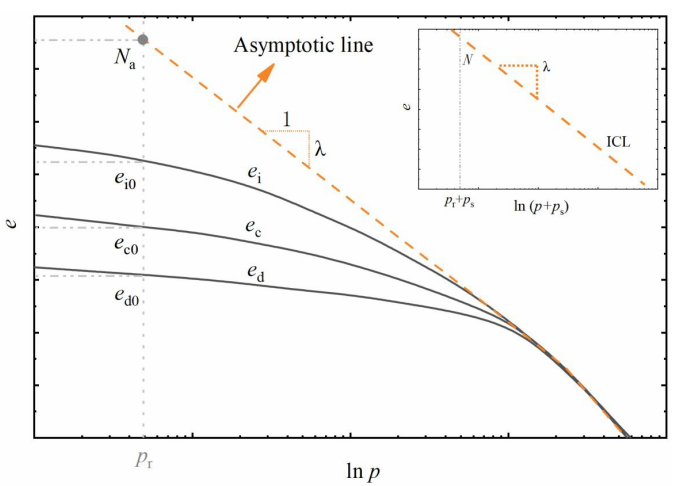
A Unified Thermo-mechanical Constitutive Model for Sand and Clay Based on Hypoplasticity
Qianqian Liu, Chao Shi# (# corresponding author)
Computers and Geotechnics 2025
Existing hypoplastic models treat sands and clays as different materials with distinct mathematical formulations. However, sands and clays share many common features in their mechanical behavior, and there is still no unified hypoplastic framework that can concisely describe the behavior of different soil types under various environmental factors, such as temperature variations. To address these challenges, this study develops a unified hypoplastic model that can describe the thermo-mechanical behavior of various soil types. The model naturally reduces to the isothermal hypoplastic formulation at a reference temperature and further simplifies to the respective sand and clay models under specific conditions, highlighting its unifying and extensible structure. The Hypo-UT model can be readily calibrated through standard tests, providing a practical and robust tool for simulating and analyzing soil behavior under thermal loading in geotechnical engineering.
A Unified Thermo-mechanical Constitutive Model for Sand and Clay Based on Hypoplasticity
Qianqian Liu, Chao Shi# (# corresponding author)
Computers and Geotechnics 2025
Existing hypoplastic models treat sands and clays as different materials with distinct mathematical formulations. However, sands and clays share many common features in their mechanical behavior, and there is still no unified hypoplastic framework that can concisely describe the behavior of different soil types under various environmental factors, such as temperature variations. To address these challenges, this study develops a unified hypoplastic model that can describe the thermo-mechanical behavior of various soil types. The model naturally reduces to the isothermal hypoplastic formulation at a reference temperature and further simplifies to the respective sand and clay models under specific conditions, highlighting its unifying and extensible structure. The Hypo-UT model can be readily calibrated through standard tests, providing a practical and robust tool for simulating and analyzing soil behavior under thermal loading in geotechnical engineering.
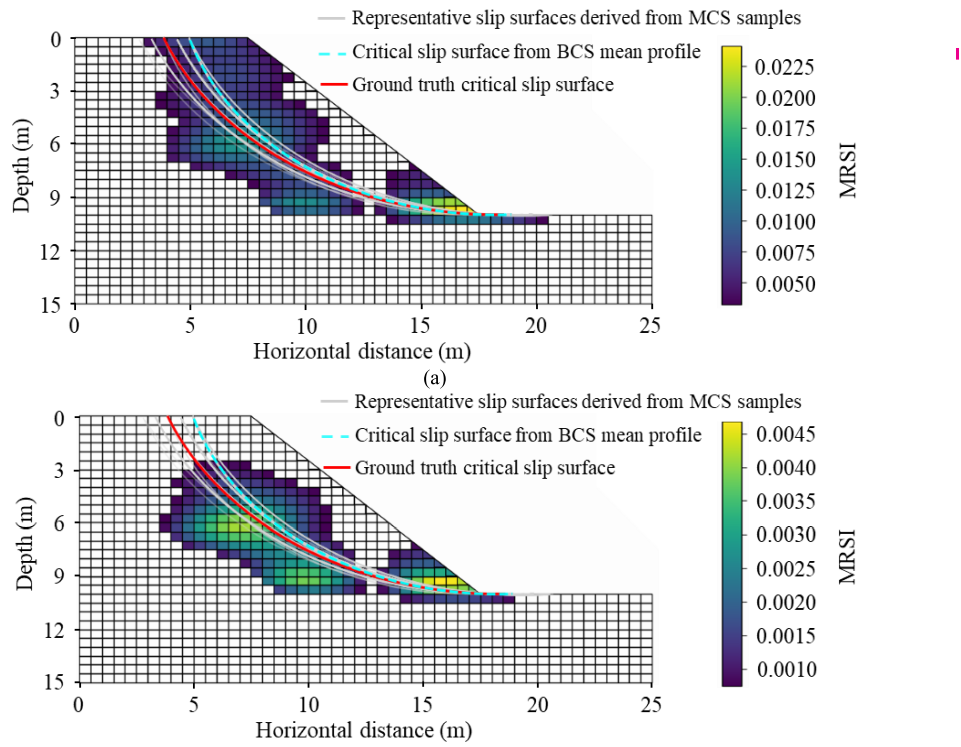
Critical Failure Domain-Informed Smart Sampling for Slope Stability Assessment using Bayesian Compressive Sensing and Reliability Sensitivity Analysis
Fanhua Meng, Huafu Pei, Chao Shi# (# corresponding author)
Reliability Engineering & System Safety 2025
This study develops a data-driven sampling strategy that integrates multi-task Bayesian compressive sensing (BCS), Karhunen–Loeve expansion, and reliability sensitivity analysis (RSA) to adaptively identify critical failure domains and optimize borehole planning. The framework introduces a nonparametric method for interpolating cross-correlated soil fields, incorporates a spatially continuous mean reliability sensitivity indicator (MRSI) derived from FORM to guide domain identification, and extends the analysis to multi-mode failure mechanisms through multi-point FORM. The optimal borehole locations are adaptively determined based on the principle of a maximum reduction in cumulative MRSI. The proposed method is illustrated through both a simulated example and real-life investigation data. Results indicate that the proposed framework can automatically identify critical failure domains for slope reliability analysis, and the determined optimal sampling locations can significantly improve the accuracy of slope reliability analysis.
Critical Failure Domain-Informed Smart Sampling for Slope Stability Assessment using Bayesian Compressive Sensing and Reliability Sensitivity Analysis
Fanhua Meng, Huafu Pei, Chao Shi# (# corresponding author)
Reliability Engineering & System Safety 2025
This study develops a data-driven sampling strategy that integrates multi-task Bayesian compressive sensing (BCS), Karhunen–Loeve expansion, and reliability sensitivity analysis (RSA) to adaptively identify critical failure domains and optimize borehole planning. The framework introduces a nonparametric method for interpolating cross-correlated soil fields, incorporates a spatially continuous mean reliability sensitivity indicator (MRSI) derived from FORM to guide domain identification, and extends the analysis to multi-mode failure mechanisms through multi-point FORM. The optimal borehole locations are adaptively determined based on the principle of a maximum reduction in cumulative MRSI. The proposed method is illustrated through both a simulated example and real-life investigation data. Results indicate that the proposed framework can automatically identify critical failure domains for slope reliability analysis, and the determined optimal sampling locations can significantly improve the accuracy of slope reliability analysis.
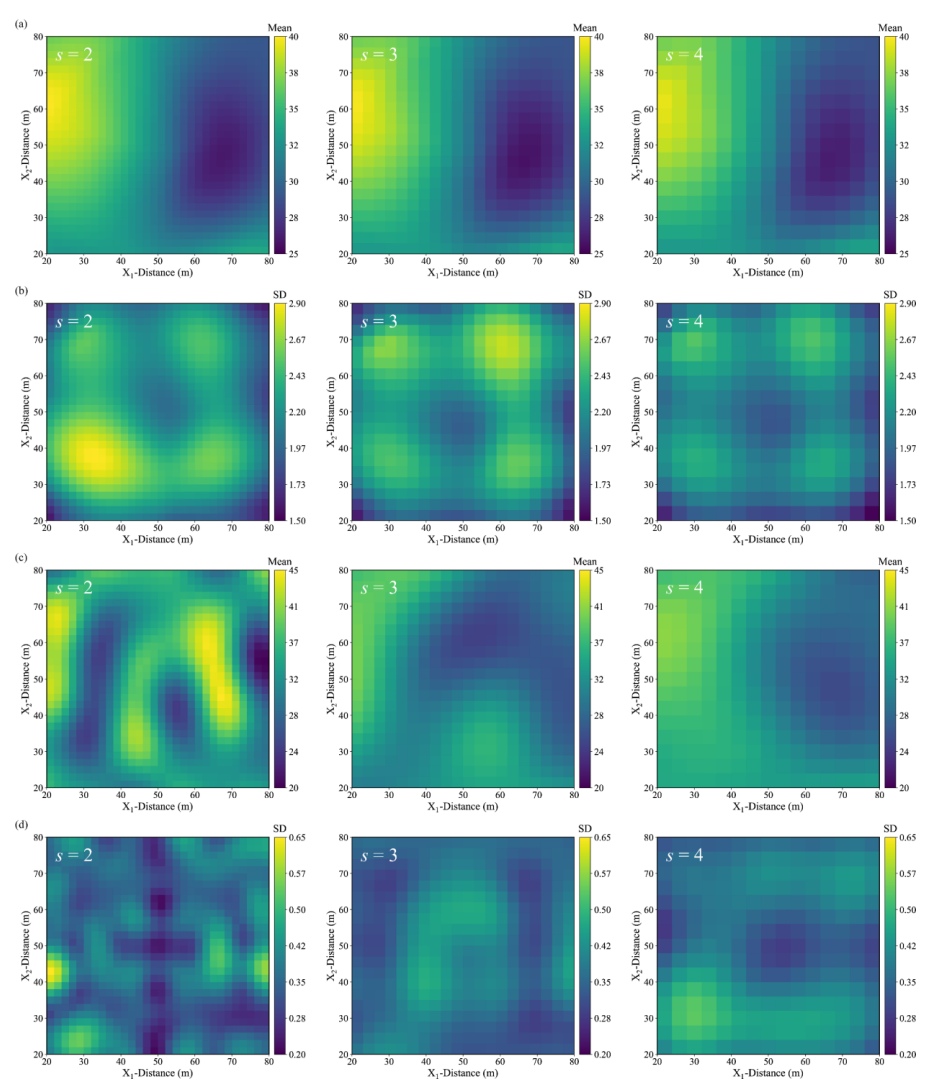
Sparse Representation of Irregularly Sampled Geotechnical Data for Probabilistic Gridded Spatial Interpolation using Dictionary Learning
Wei Hu, Chao Shi#, Yu Wang (# corresponding author)
Computers and Geotechnics 2025
This study proposes a space transformation approach to derive a sparse representation of irregularly sampled geodata for gridded spatial interpolation. Spatially varying measurements with an irregular data distribution are first mapped onto a regular grid via affine transformation, and Bayesian compressive sensing is then adopted to generate conditional spatial predictions with quantified statistical uncertainty from the transformed dataset. Subsequently, the predicted random field samples are converted back into the original irregular data space, preserving the correspondence between points across the different data spaces.
Sparse Representation of Irregularly Sampled Geotechnical Data for Probabilistic Gridded Spatial Interpolation using Dictionary Learning
Wei Hu, Chao Shi#, Yu Wang (# corresponding author)
Computers and Geotechnics 2025
This study proposes a space transformation approach to derive a sparse representation of irregularly sampled geodata for gridded spatial interpolation. Spatially varying measurements with an irregular data distribution are first mapped onto a regular grid via affine transformation, and Bayesian compressive sensing is then adopted to generate conditional spatial predictions with quantified statistical uncertainty from the transformed dataset. Subsequently, the predicted random field samples are converted back into the original irregular data space, preserving the correspondence between points across the different data spaces.
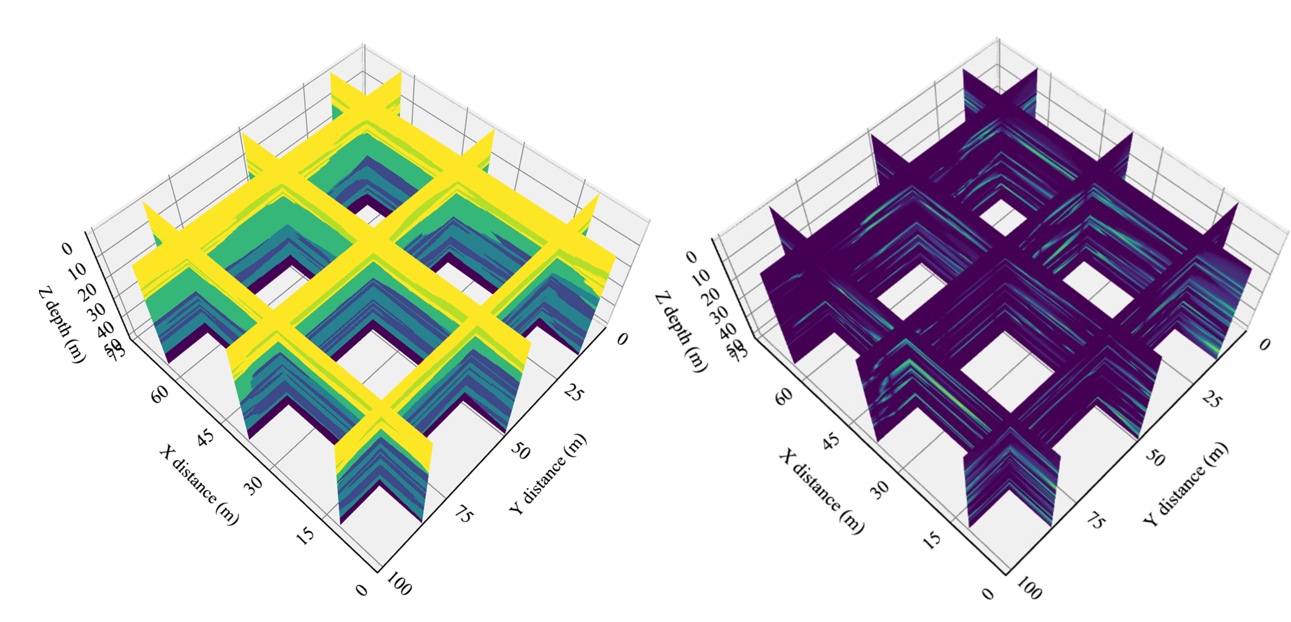
A Quasi-manifold-based Probabilistic Method for Real-time Interpretation of Interbedded Strata from Sparse Boreholes
Zehang Qian, Chao Shi# (# corresponding author)
Geotechnique 2025
This study proposes a quasi-manifold learning approach to address these challenges in a stochastic and non-parametric manner. Sparse and incomplete borehole measurements are first transformed from a low-dimensional categorical feature space into a high-dimensional continuous feature space, providing a richer representation of inclusion characteristics. A quasi-manifold-based spatial interpolator is then developed to stochastically interpret high-dimensional features by traversing an embedded manifold, which concisely preserves the essential and meaningful stratigraphic patterns. Subsequently, inverse transformations convert the spatially predicted continuous variables back to categorical feature spaces for constructing two-dimensional geological cross-sections and three-dimensional domains with quantified stratigraphic uncertainty.
A Quasi-manifold-based Probabilistic Method for Real-time Interpretation of Interbedded Strata from Sparse Boreholes
Zehang Qian, Chao Shi# (# corresponding author)
Geotechnique 2025
This study proposes a quasi-manifold learning approach to address these challenges in a stochastic and non-parametric manner. Sparse and incomplete borehole measurements are first transformed from a low-dimensional categorical feature space into a high-dimensional continuous feature space, providing a richer representation of inclusion characteristics. A quasi-manifold-based spatial interpolator is then developed to stochastically interpret high-dimensional features by traversing an embedded manifold, which concisely preserves the essential and meaningful stratigraphic patterns. Subsequently, inverse transformations convert the spatially predicted continuous variables back to categorical feature spaces for constructing two-dimensional geological cross-sections and three-dimensional domains with quantified stratigraphic uncertainty.
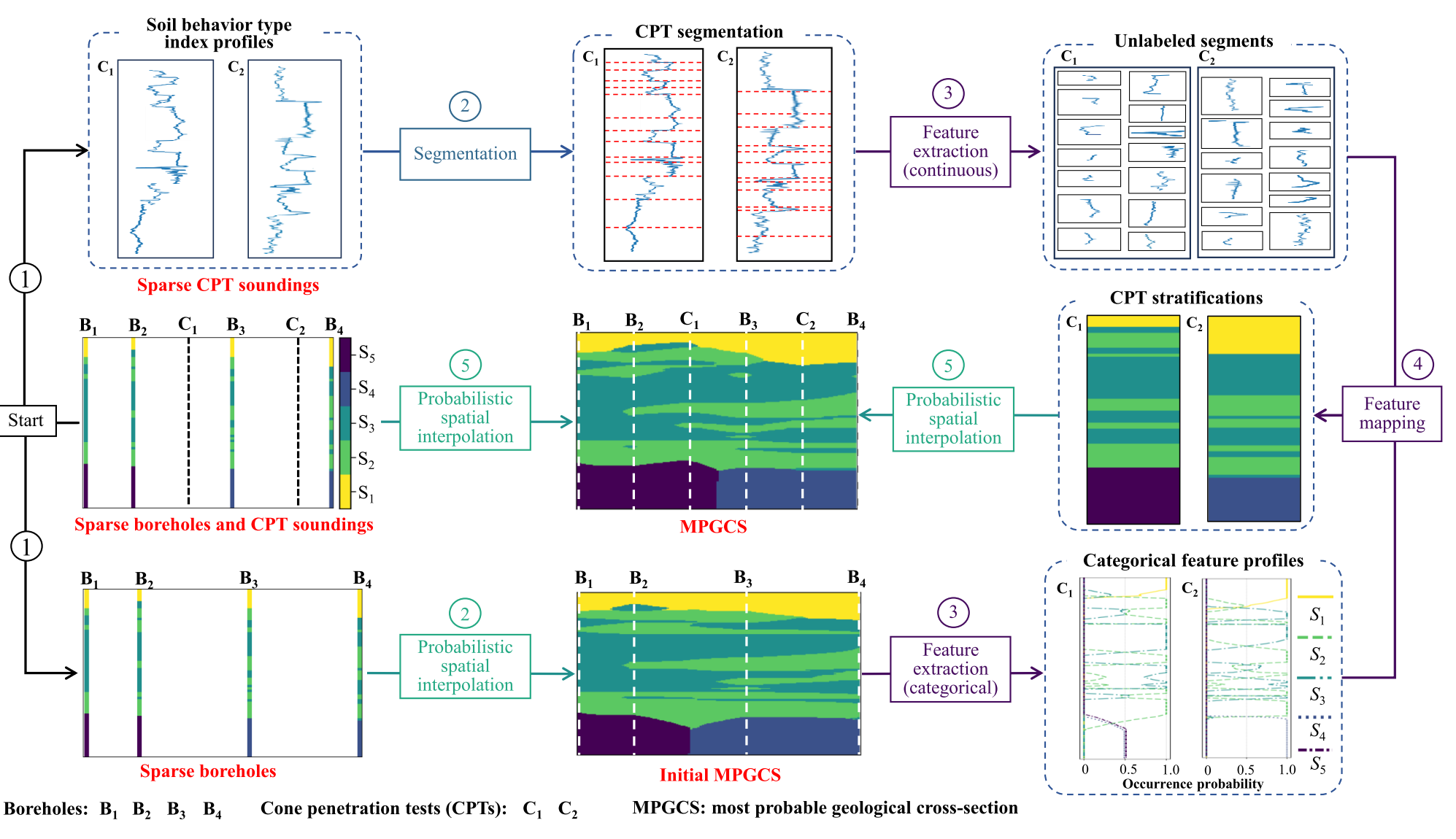
A Dual-modal Feature Learning Approach for Probabilistic Semi-supervised Interpretation of Subsurface Stratigraphy from Sparse Boreholes and Cone Penetration Tests
Qian Zehang, Chao Shi#, Siew-Wei Lee (# corresponding author)
Journal of Geotechnical and Geoenvironmental Engineering 2025
This study proposes a dual-modal feature learning approach for semi-supervised learning of subsurface stratigraphy from sparse site-specific data with quantified uncertainty.
A Dual-modal Feature Learning Approach for Probabilistic Semi-supervised Interpretation of Subsurface Stratigraphy from Sparse Boreholes and Cone Penetration Tests
Qian Zehang, Chao Shi#, Siew-Wei Lee (# corresponding author)
Journal of Geotechnical and Geoenvironmental Engineering 2025
This study proposes a dual-modal feature learning approach for semi-supervised learning of subsurface stratigraphy from sparse site-specific data with quantified uncertainty.
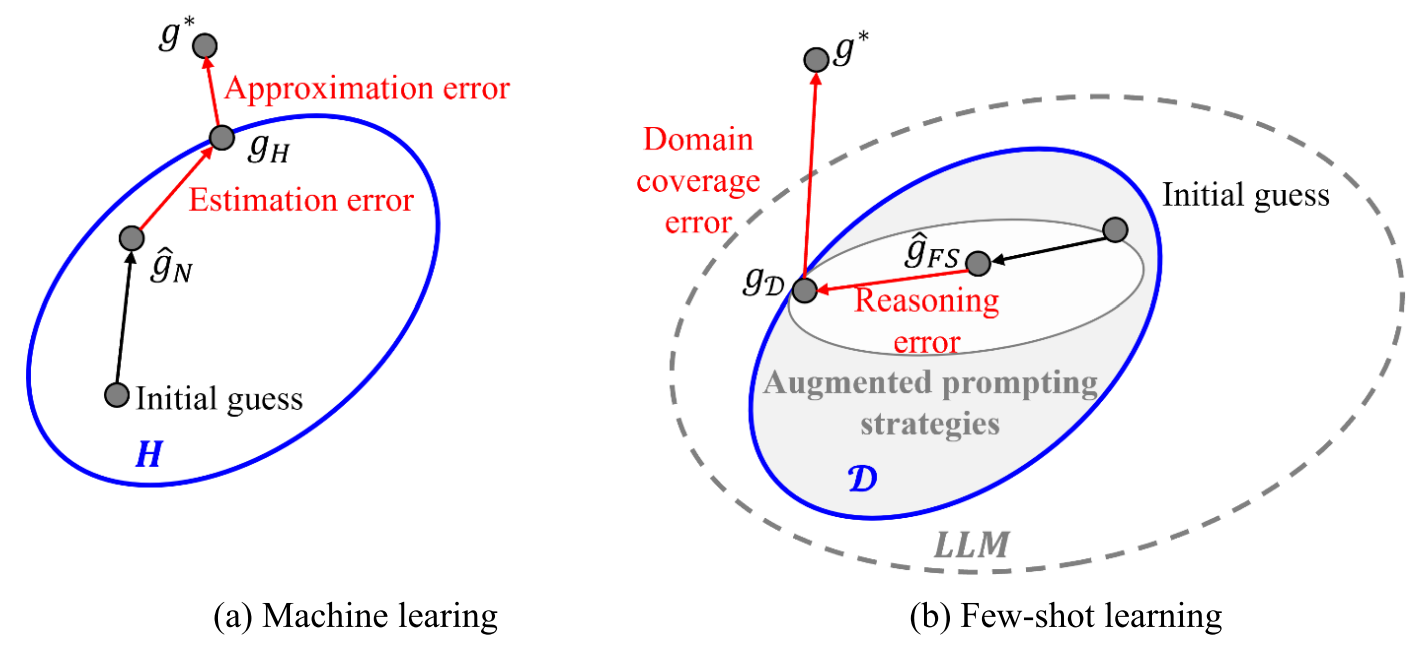
Few-shot Learning of Geological Cross-sections from Sparse Data using Large Language Model
Hanyue Li, Chao Shi# (# corresponding author)
Geodata and AI 2025
Artificial intelligence (AI) has achieved remarkable milestones and surpassed human capabilities in many fields, such as Go and image recognition. There have been numerous efforts to leverage AI in promoting digitalization and automation in civil engineering. This is particularly challenging in geotechnical engineering, where geological modelling still heavily depends on subjective prior knowledge and is hindered by data scarcity. Therefore, incorporating valuable prior knowledge for the automatic development of subsurface geological cross-sections from sparse geodata remains an unsolved challenge. To address these issues, this study proposes a few-shot learning strategy based on large language models (LLMs) to generate two-dimensional geological cross-sections from sparse site investigation data...
Few-shot Learning of Geological Cross-sections from Sparse Data using Large Language Model
Hanyue Li, Chao Shi# (# corresponding author)
Geodata and AI 2025
Artificial intelligence (AI) has achieved remarkable milestones and surpassed human capabilities in many fields, such as Go and image recognition. There have been numerous efforts to leverage AI in promoting digitalization and automation in civil engineering. This is particularly challenging in geotechnical engineering, where geological modelling still heavily depends on subjective prior knowledge and is hindered by data scarcity. Therefore, incorporating valuable prior knowledge for the automatic development of subsurface geological cross-sections from sparse geodata remains an unsolved challenge. To address these issues, this study proposes a few-shot learning strategy based on large language models (LLMs) to generate two-dimensional geological cross-sections from sparse site investigation data...
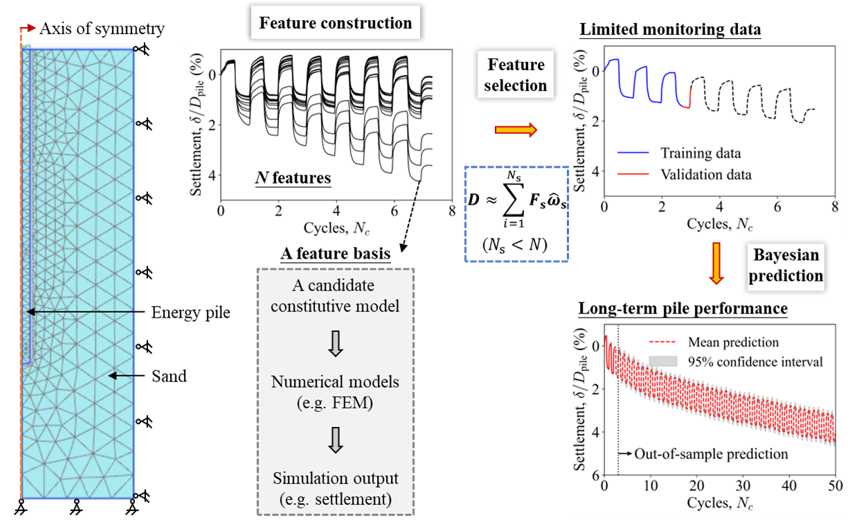
Interpretable ensemble prediction of thermally induced long-term pile settlement from limited monitoring data
Bo Sun, Chao Shi# (# corresponding author)
Journal of Geotechnical and Geoenvironmental Engineering 2025
Predicting long-term pile settlement induced by seasonal heating and cooling cycles is crucial for the safety and serviceability of energy piles. However, traditional numerical methods are limited by the inadequacies of soil constitutive models, and machine learning approaches typically require large datasets and lack interpretability. To address these challenges, this study proposes an interpretable sparse ensemble learning (ISEL) method that integrates finite element model outputs with limited monitoring data to dynamically predict thermally induced long-term pile displacement.
Interpretable ensemble prediction of thermally induced long-term pile settlement from limited monitoring data
Bo Sun, Chao Shi# (# corresponding author)
Journal of Geotechnical and Geoenvironmental Engineering 2025
Predicting long-term pile settlement induced by seasonal heating and cooling cycles is crucial for the safety and serviceability of energy piles. However, traditional numerical methods are limited by the inadequacies of soil constitutive models, and machine learning approaches typically require large datasets and lack interpretability. To address these challenges, this study proposes an interpretable sparse ensemble learning (ISEL) method that integrates finite element model outputs with limited monitoring data to dynamically predict thermally induced long-term pile displacement.
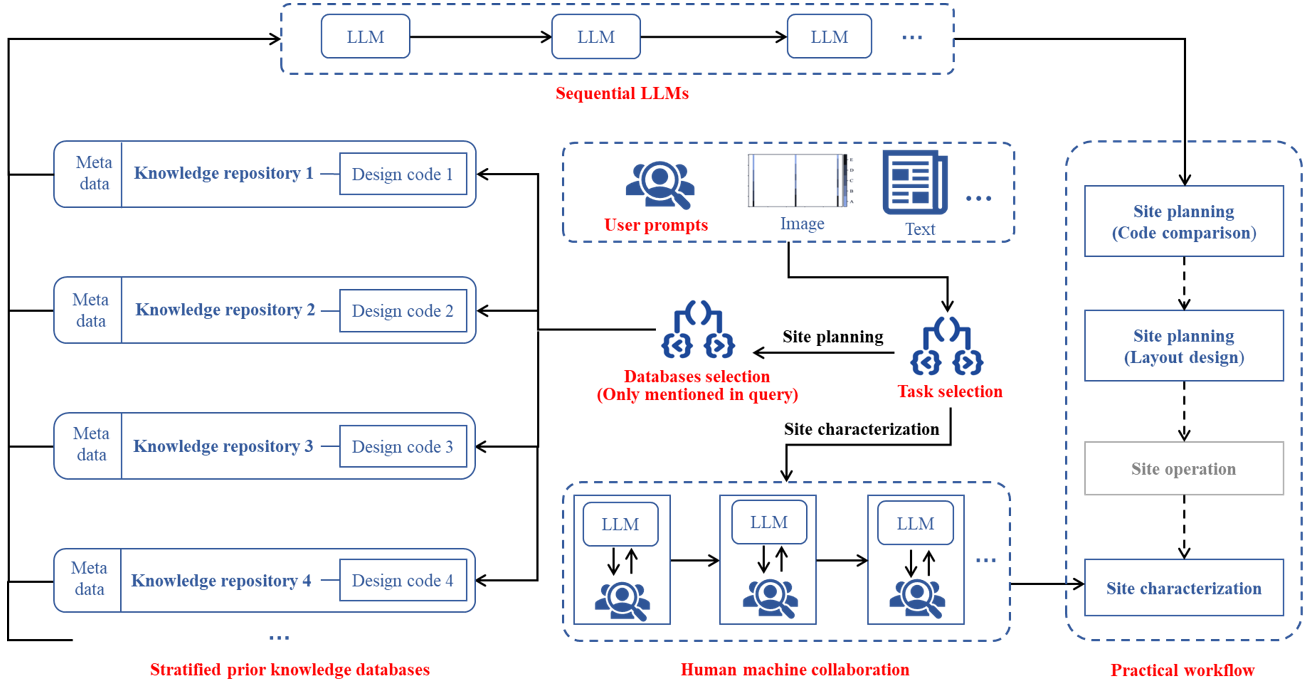
Large Language Model-empowered Paradigm for Automated Geotechnical Site Planning and Geological Characterization
Zehang Qian, Chao Shi# (# corresponding author)
Automation in Construction 2025
This paper develops a customized LLM-based agent named “Geologist” to streamline geotechnical site planning and subsequent geological interpretation. A Multihop-Retrieval-Augmented Generation system is proposed to retrieve site-specific requirements from multiple site investigation design codes. Moreover, a progressive human-machine collaboration scheme is orchestrated for interpretable geological modelling. The efficiency of the proposed LLM-guided paradigm is validated through illustrative examples and real-world case histories.
Large Language Model-empowered Paradigm for Automated Geotechnical Site Planning and Geological Characterization
Zehang Qian, Chao Shi# (# corresponding author)
Automation in Construction 2025
This paper develops a customized LLM-based agent named “Geologist” to streamline geotechnical site planning and subsequent geological interpretation. A Multihop-Retrieval-Augmented Generation system is proposed to retrieve site-specific requirements from multiple site investigation design codes. Moreover, a progressive human-machine collaboration scheme is orchestrated for interpretable geological modelling. The efficiency of the proposed LLM-guided paradigm is validated through illustrative examples and real-world case histories.
2024
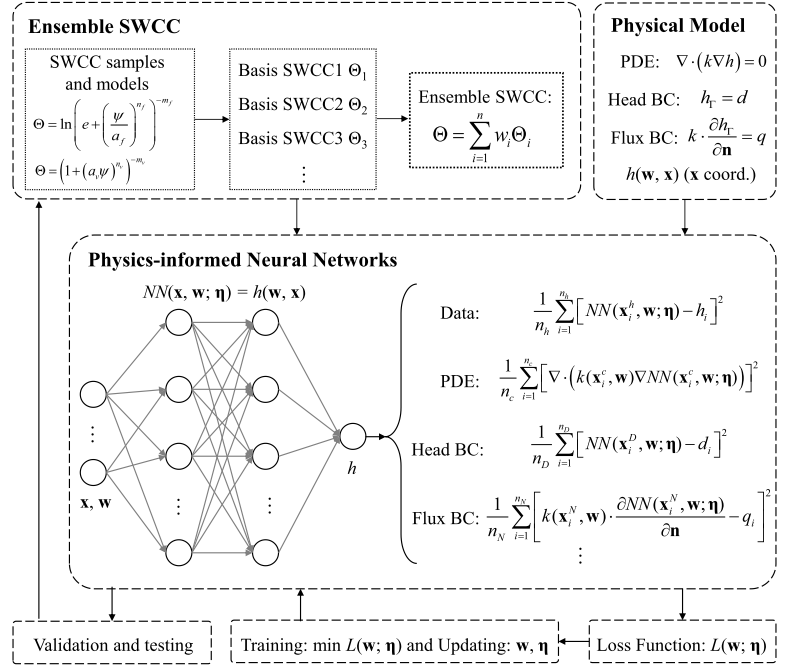
Ensemble Learning of Soil-water Characteristic Curve for Unsaturated Seepage using Physics-informed Neural Netowrks
Haoqing Yang, Chao Shi#, Lulu Zhang (# corresponding author)
Soils and Foundations 2024
This study proposes an ensemble learning framework that leverages physics-informed neural networks (PINN) for parameter estimation. Multiple representative SWCCs following different function forms are compiled, providing flexible learning basis to construct arbitrary SWCC. For a specific slope, the most compatible basis combination is adaptively selected based on limited site-specific measurements before being mobilized for forward predictions of hydraulic behavior.
Ensemble Learning of Soil-water Characteristic Curve for Unsaturated Seepage using Physics-informed Neural Netowrks
Haoqing Yang, Chao Shi#, Lulu Zhang (# corresponding author)
Soils and Foundations 2024
This study proposes an ensemble learning framework that leverages physics-informed neural networks (PINN) for parameter estimation. Multiple representative SWCCs following different function forms are compiled, providing flexible learning basis to construct arbitrary SWCC. For a specific slope, the most compatible basis combination is adaptively selected based on limited site-specific measurements before being mobilized for forward predictions of hydraulic behavior.
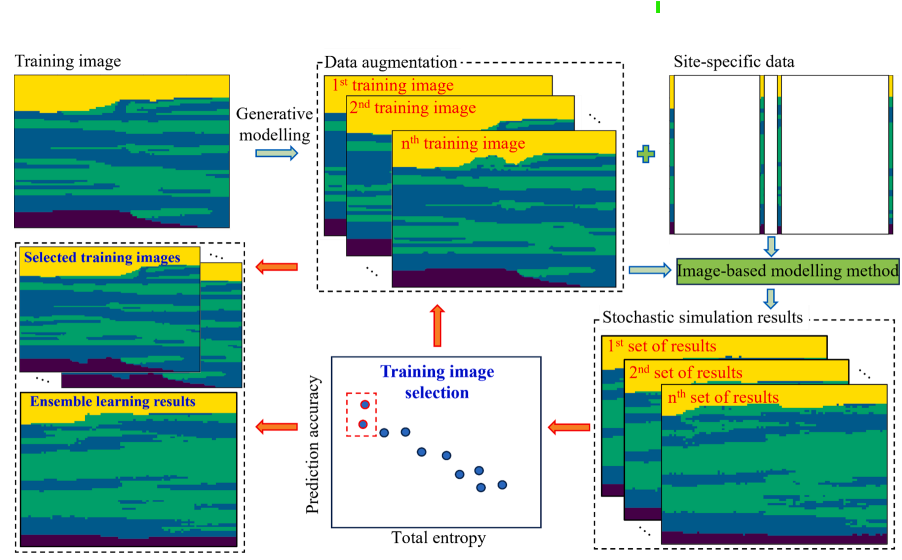
An ensemble learning paradigm for subsurface stratigraphy from sparse measurements and augmented training images
Chao Shi#, Yu Wang, Haoqing Yang (# corresponding author)
Tunnelling and Underground Space Technology 2024
A domain-specific training image database is first established using generative adversarial networks (GAN) that enable the generation of arbitrary sized image samples from a single training image. Subsequently, multiple qualified image samples that are compatible with site-specific data are adaptively selected and utilized for the ensemble learning of geological cross-sections.
An ensemble learning paradigm for subsurface stratigraphy from sparse measurements and augmented training images
Chao Shi#, Yu Wang, Haoqing Yang (# corresponding author)
Tunnelling and Underground Space Technology 2024
A domain-specific training image database is first established using generative adversarial networks (GAN) that enable the generation of arbitrary sized image samples from a single training image. Subsequently, multiple qualified image samples that are compatible with site-specific data are adaptively selected and utilized for the ensemble learning of geological cross-sections.
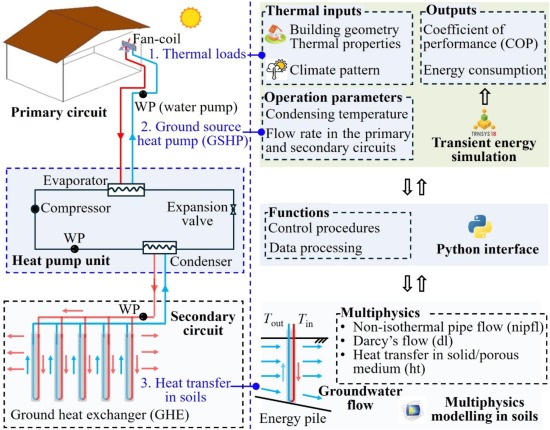
Dynamically coupled modelling of ground source heat pump systems considering groundwater flow and unbalanced seasonal building thermal loads
Yuanzhong Yan, Chao Shi, Gongsheng Huang, Yu Wang
Applied Thermal Engineering 2024
To properly evaluate the long-term COP of GSHP systems in cooling-dominated areas, a dynamically coupled simulation approach is proposed in this study. The proposed method integrates building thermal loads with ground heat transfer under groundwater seepage flow, within a unified framework.
Dynamically coupled modelling of ground source heat pump systems considering groundwater flow and unbalanced seasonal building thermal loads
Yuanzhong Yan, Chao Shi, Gongsheng Huang, Yu Wang
Applied Thermal Engineering 2024
To properly evaluate the long-term COP of GSHP systems in cooling-dominated areas, a dynamically coupled simulation approach is proposed in this study. The proposed method integrates building thermal loads with ground heat transfer under groundwater seepage flow, within a unified framework.
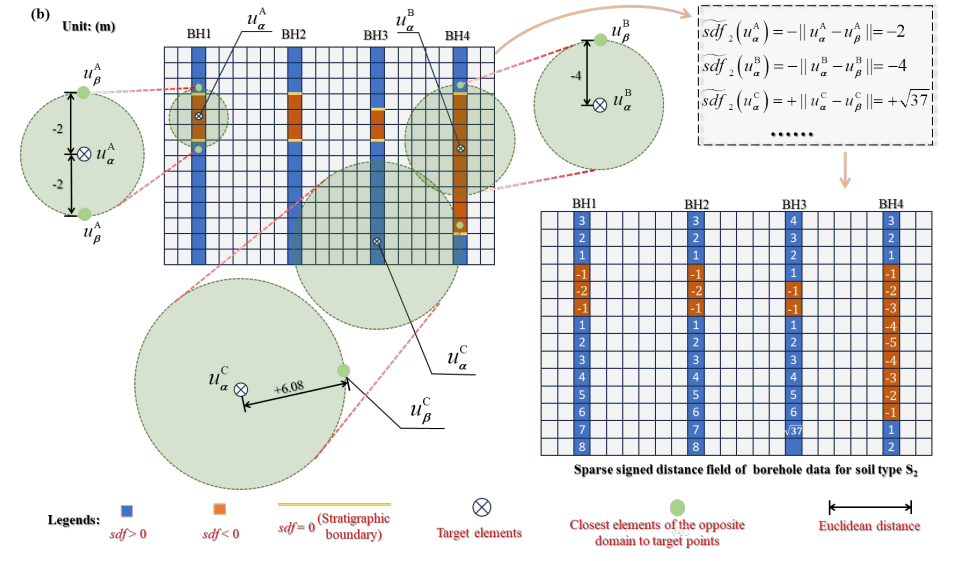
Nonparametric and Continuous Variable-Based Stratigraphic Modelling from Sparse Boreholes using Signed Distance Function and Bayesian Compressive Sensing
Zehang Qian, Chao Shi#, Yu Wang, Zijun Cao (# corresponding author)
Canadian Geotechnical Journal 2025
In this study, a non-parametric and continuous variable-based spatial predictor that leverages the signed distance function and Bayesian compressive sensing (BCS) is proposed for subsurface stratigraphic modelling. The proposed method transforms sparse categorical borehole data from a low-dimensional space into continuous variables in a high-dimensional space, enabling a comprehensive representation of more implicit characteristics of intricate geological patterns..
Nonparametric and Continuous Variable-Based Stratigraphic Modelling from Sparse Boreholes using Signed Distance Function and Bayesian Compressive Sensing
Zehang Qian, Chao Shi#, Yu Wang, Zijun Cao (# corresponding author)
Canadian Geotechnical Journal 2025
In this study, a non-parametric and continuous variable-based spatial predictor that leverages the signed distance function and Bayesian compressive sensing (BCS) is proposed for subsurface stratigraphic modelling. The proposed method transforms sparse categorical borehole data from a low-dimensional space into continuous variables in a high-dimensional space, enabling a comprehensive representation of more implicit characteristics of intricate geological patterns..
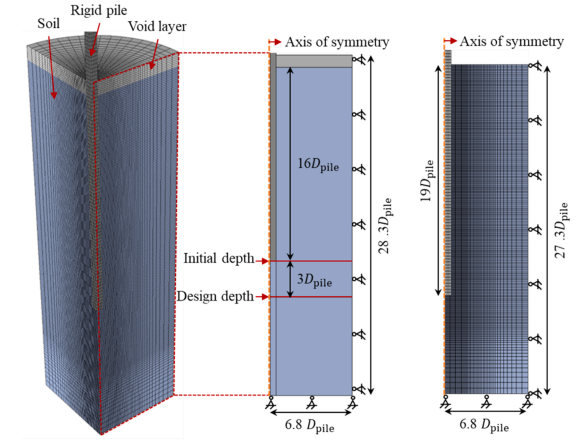
Numerical Investigation on Thermomechanical Behavior of Driven Energy Piles Subjected to Cyclic Thermal Loading in Sand
Bo Sun, Chao Shi#, Anthony Leung (# corresponding author)
Computers and Geotechnics 2024
Although there has been extensive research on bored energy piles, the understanding about the thermomechanical performance of driven energy piles remains limited. In this study, a unified numerical modeling campaign is proposed to investigate the thermomechanical behaviors of driven energy piles in sand under cyclic thermal loading conditions. The pile-driving process is simulated using the Coupled Eulerian-Lagrangian (CEL) technique, and the obtained post-installation results are mapped to an axisymmetric finite element model to analyze the thermomechanical behavior of driven energy piles.
Numerical Investigation on Thermomechanical Behavior of Driven Energy Piles Subjected to Cyclic Thermal Loading in Sand
Bo Sun, Chao Shi#, Anthony Leung (# corresponding author)
Computers and Geotechnics 2024
Although there has been extensive research on bored energy piles, the understanding about the thermomechanical performance of driven energy piles remains limited. In this study, a unified numerical modeling campaign is proposed to investigate the thermomechanical behaviors of driven energy piles in sand under cyclic thermal loading conditions. The pile-driving process is simulated using the Coupled Eulerian-Lagrangian (CEL) technique, and the obtained post-installation results are mapped to an axisymmetric finite element model to analyze the thermomechanical behavior of driven energy piles.

Data-driven forward and inverse analysis of two-dimensional soil consolidation using physics-informed neural network
Yu Wang, Chao Shi#, Jiangwei Shi, Hu Lu (# corresponding author)
Acta Geotechnica 2024
Although pure data-driven models demonstrate strong performance within their training domain, i.e., in-sample prediction, they lack interpretability and might have poor generalization outside the training domain, i.e., out-of-sample prediction, particularly when the observed geodata is limited. Moreover, these models often disregard valuable geotechnical domain knowledge. To address these limitations, a novel physics-informed neural network (PINN) is developed for both forward and inverse analyses of two-dimensional soil consolidations when only limited measurements are available.
Data-driven forward and inverse analysis of two-dimensional soil consolidation using physics-informed neural network
Yu Wang, Chao Shi#, Jiangwei Shi, Hu Lu (# corresponding author)
Acta Geotechnica 2024
Although pure data-driven models demonstrate strong performance within their training domain, i.e., in-sample prediction, they lack interpretability and might have poor generalization outside the training domain, i.e., out-of-sample prediction, particularly when the observed geodata is limited. Moreover, these models often disregard valuable geotechnical domain knowledge. To address these limitations, a novel physics-informed neural network (PINN) is developed for both forward and inverse analyses of two-dimensional soil consolidations when only limited measurements are available.
2023
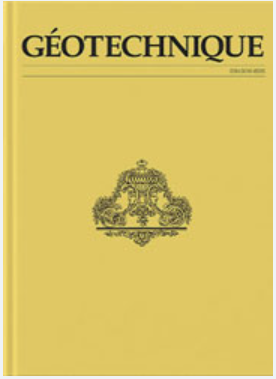
Data-driven spatio-temporal analysis of consolidation for rapid reclamation
Chao Shi, Yu Wang
Géotechnique 2023
In this study, a unified framework, capable of simultaneously modelling stratigraphic variation and spatial variability of soil properties through machine learning of limited site investigation data, is combined with the finite-element method and Monte Carlo simulation for spatio-temporal consolidation analysis of reclaimed lands.
Data-driven spatio-temporal analysis of consolidation for rapid reclamation
Chao Shi, Yu Wang
Géotechnique 2023
In this study, a unified framework, capable of simultaneously modelling stratigraphic variation and spatial variability of soil properties through machine learning of limited site investigation data, is combined with the finite-element method and Monte Carlo simulation for spatio-temporal consolidation analysis of reclaimed lands.
Others
36. Chen, W., Shi, C., Ding, J., Wnag, T. and Connolly, D. Data-driven sparse learning of three-dimensional subsurface properties incorporating random field theory. 2025. Engineering Geology, in press.
35. Tian, H., Wang, Y. and Shi, C. 2024. Machine Learning-aided selection of CPT-based transformation models using monitoring data from a specific project, Acta geotechnica, in press.
34. Li, P. and Shi, C. 2024. Efficient basis-adaptive Bayesian compressive sensing with fast leave-one-out cross-validation for reliability analysis of geotechnical engineering systems, Computers and Geotechnics, in press.
33. Lu, H., Zhao., W., Fu, Y., Ma, S., Lu, Z., Yang, R., Ding, Z. and Shi, C.* 2024. Enhancing Anti-carbonation Properties of Oil Well Cement Slurry through Nanoparticle and Cellulose Fiber Synergy. Construction and Building Materials, Vol. 450, 138578.
32. Shi, J., Zhong, X., Lu, H., Ni, X. and Shi, C.* 2024. Influence of joint stiffness on three-dimensional deformation mechanisms of pipelines under tunnel active face instability. Canadian Geotechnical Journal, in press.
31. Khajehzadeh, M., Keawsawasvong, S., Kamchoom, V., Shi, C. and Khajehzadeh, A., 2024. Developing an effective optimized machine learning approaches for settlement prediction of shallow foundation. Heliyon.
30. Qian, Z. and Shi, C.* 2024. Prior geological knowledge enhanced markov random field for development of geological cross-sections from sparse data. Computers and Geotechnics, 173, p.106587.
29. Shi, J., Chen, Y., Kong, G., Lu., H., Chen, G. and Shi, C. 2024. Deformation mechanisms of an existing pipeline due to progressively passive instability of tunnel face: physical and numerical investigations. Tunelling and Underground Space Technology, 150, p.105822.
28. Chen, W., Ding, J., Shi, C., Wang, T. and Connoly, D. 2024. Geotechnical correlation field-informed and data-driven prediction of spatially varying geotechnical properties. Computers and Geotechnics, 171, p. 106407.
27. Lyu, B, Wang, Y. and Shi, C. 2024. Multi-scale generative adversarial networks for generation of three-dimensional subsurface geological models from limited boreholes and prior geological knowledge. Computers and Geotechnics, 170, p.106336.
26. Cui, S., Zhou, C., Shi, C. and Lu, H. 2024. Thermo-mecahnical behavior of energy piles with different roughness values in unsaturated soil. Journal of Geotechnical and Geoenvironmental Engineering, 150 (5), p.04024035.
25. Shi, C., Wang, Y. and Kamchoom, V. 2023. Data-driven Multi-stage Sampling Strategy for a Three-dimensional Geological Domain using Weighted Centroidal Voronoi Tessellation and IC-XGBoost3D. Engineering Geology, 325, p. 107301.
24. Lu, H., Shi, J., Shi, C.,* Pei, W. and Chen, S. 2023. Assessment of Twin Tunnelling Induced Settlement and Load Transfer Mechanism of a Single Pile in Dry Sand. Canadian Geotechnical Journal, 61 (5), 1004-1017.
23. Shi, C.*, Jin, Y., Lu, H. and Shi, J. 2023. A BIM-based Framework for Automatic Numerical Modelling and Geotechnical Analyisis of a Large-scale Deep Excavation for Transportation Infrastructures. Intelligent Transportation Infrastructure, 2, p.liad012.
22. Shi, J., Wang, J., Chen, Y., Shi, C. et al. 2023. Physical Modeling of the Influence of Tunnel Active Face Instability on Existing Pipelines. Tunnelling and Underground Space Technology, 140, 105281.
21. Lu, H., Yu, R., Shi, C.*, Pei, W. 2023.Field Investigation and Numerical Study of Ground Movement Due to Pipe Pile Wall Installation in Reclaimed Land. Geomechanics and Engineering, 34 (4), 397-408.
20. Borui Lyu, Wang, Y., Shi, C. and Hu, Y. 2023.Non-parametric Simulation of Random Field Samples from Incomplete Measurements using Generative Adversarial Networks. Georisk, 18 (1), 60-84.
19. Shi, C. and Wang, Y. 2023. Development of training image database for subsurface stratigraphy. Georisk, 12(1), 23-40.
18. Wang, Y. and Shi, C. 2023. Data-driven Analysis of Soil Consolidation with Prefabricated Vertical Drains Considering Stratigraphic Variation. Computers and Geotechnics, 161, p.105569.
17. Shi, C. and Wang, Y. 2022. Machine learning of three-dimensional subsurface geological model for a reclamation site in Hong Kong. Bulletin of Engineering Geology and the Environment, 81(12), p.504.
16. Shi, C. and Wang, Y. 2022. Data-driven sequential development of geological cross-section along tunnel trajectory. Acta Geotechnica, 18, 1739–1754.
15. Shi, C. and Wang, Y. 2022. Stochastic analysis of load transfer mechanism of energy piles by random finite difference model. Journal of Rock Mechanics and Geotechnical Engineering, 15(4), 997-1010.
14. Shi, C. and Wang, Y. 2022. Data-driven digital twin construction of subsurface three-dimensional geological domain from training images and limited site-specific boreholes using IC-XGBoost3D. Tunnelling and Underground Space Technology, 126, p.104493.
13. Wang, Y., Shi, C.* and Li, X. 2022. Machine learning of geological details from borehole logs for development of high-resolution subsurface geological cross-section and geotechnical analysis. Georisk, 16(1): 2-20.
12. Shi, C. and Wang, Y. 2022. Assessment of reclamation-induced consolidation settlement considering stratigraphic uncertainty and spatial variability of soil properties. Canadian Geotechnical Journal, 59(7): 1215-1230.
11. Shi, J., Wei, J., Ng, C. W. W., Ma, S. K., Shi, C. and Li, P. 2022. Effects of construction sequence of double basement excavations on an existing floating pile. Tunnelling and Underground Space Technology, 119, 104230.
10. Shi, C. and Wang, Y. 2021. Non-parametric and data-driven interpolation of subsurface soil stratigraphy from limited data using multiple point statistics. Canadian Geotechnical Journal, 58(2): 261-280.
9. Shi, C. and Wang, Y. 2021. Non-parametric machine learning methods for interpolation of spatially varying non-stationary and non-Gaussian geotechnical properties. Geoscience Frontier, 12(1): 339-350.
8. Shi, C. and Wang, Y. 2021. Smart Determination of Borehole Number and Locations for Stability Analysis of Multi-layered Slopes using Multiple Point Statistics and Information Entropy. Canadian Geotechnical Journal, 58(11):1669-1689.
7. Shi, C. and Wang, Y. 2021. Development of Subsurface Geological Cross-section from limited site-specific boreholes and prior geological knowledge using iterative convolution XGBoost. Journal of Geotechnical and Geoenvironmental Engineering, 147(9), 04021082.
6. Shi, C. and Wang, Y. 2021. Training image selection for development of subsurface geological cross-section, Engineering Geology, 295(20), 106415.
5. Shi, C. and Zhuang, X. 2019. A study concerning soft computing approaches for stock price forecasting. Axioms, 8(4): 116.
4. Ng, C. W. W., Gunawan, A., Shi, C. and Ma, Q. J. 2015. Centrifuge modelling of displacement and replacement energy piles constructed in saturated sand: a comparative study. Geotechnique letter, 6(1): 34-38.
3. Rotta Loria, A. F., Gunawan, A., Shi, C., Laloui, L. and Ng, C. W. W. 2015. Numerical modelling of energy piles in saturated sand. Geomechanics for Energy and the Environment. Volume 1, pp: 1–15.
2. Ng, C. W. W., Shi, C. *, Gunawan, A., Laloui, L and Liu, H. L. 2014. Centrifuge modelling of heating effects on energy pile performance in saturated sand. Canadian Geotechnical Journal, 52(8): 1045-1057.
1. Ng, C. W. W., Shi, C. *, Gunawan, A. and Laloui, L. 2014. Centrifuge modelling of energy pile subjected to heating and cooling cycles in clay. Geotechnique letter, 4(4): 310-316.